Trucks are hugely popular; they are selling so well that major automakers like Ford and GM have been dropping cars from their lineups – in order to make room for more trucks (and truck-like SUVs).
But trucks have also been getting huge.
Current full-size trucks are so big – and so tall – that they come with ladders built into their tailgates, so as to make it possible to get to the bed.
Not everyone who needs a truck needs one that big.
Enter more manageably sized trucks like the GMC Canyon.
The Canyon is a mid-sized pick-up truck and the GMC-badged version of the Chevy Colorado pick-up.
Both trucks are mechanically identical, but each has brand-specific exterior and interior trim as well as standard/optional features.
GMC is considered a slightly more “upscale” brand than Chevy – so the Canyon’s prices are slightly higher than the Colorado’s.
You can pick up a base trim 2WD Canyon extended cab with a 6.2 foot bed, 2.5 liter engine and six-speed manual transmission for $22,200 to start vs. $21,300 for the mechanical identical Chevy version of the same truck.
A top-of-the-line Denali trim (unique to the GMC line) stickers for $44,995.
In addition to their standard four cylinder gas and optional gas V6 engines, both trucks offer a turbo-diesel four cylinder engine, a feature none of the other trucks in this class – models like the Nissan Frontier and Toyota Tacoma – currently offer.
The new Ford Ranger – which returns for 2019 after an eight-year absence from Ford’s lineup – will reportedly offer one, but not until later this year.
So for now, the GM twins are the only not-too-big trucks available with a brawny diesel engine.
They are also among the few new trucks – huge or not – still available with a manual transmission.
With a catch.
WHAT’S NEW
AppleCarPlay and Android Auto5 are standard in all trims (formerly optional in some) and all versions get an updated touchscreen/apps.
SLE trims also get a high-resolution back-up camera.
The voice recognition system has been upgraded with an additional microphone.
A Not-Too-Big truck.
Big capability – including a hunky 7,700 lb. maximum tow rating.
Available diesel engine; standard manual transmission.
WHAT’S NOT SO GOOD
No regular cab/long bed version.
4WD only available with optional V6 and diesel engine.
Manual transmission only available with the four-cylinder engine.
The Canyon offers three engine choices – an upgrade over the usual two – including the only diesel engine currently available in a mid-sized pick-up.
Standard equipment is a 2.5 liter, 200 hp four cylinder, which comes paired with a standard six-speed manual; a six-speed automatic is available optionally.
Canyons with the 2.5 liter engine are not available with 4WD.
This engine is much stronger than the Toyota Tacoma’s standard (and larger) 2.7 liter four cylinder, which only manages 159 hp. And Toyota pairs this engine with a standard automatic transmission.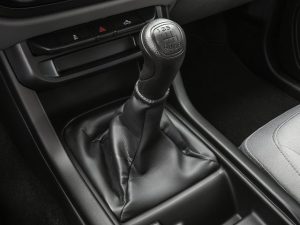
Nissan gives you the choice of standard manual or optional automatic transmissions in the 2019 Frontier, but the standard 2.5 liter engine comes in a distant third on power – just 150 – 50 horsepower fewer than the Canyon comes standard with.
The GMC’s next-up engine is a 3.6 liter V6 that makes 306 horsepower – the most horsepower in the class and not by a little bit. The Tacoma’s optional 3.5 liter V6 makes 278 horsepower and the Frontier’s 4.0 liter V6 makes 261.
So equipped, the Canyon – a 4,200 lb. pick-up – can hustle to 60 in about 7 seconds, a speedy time.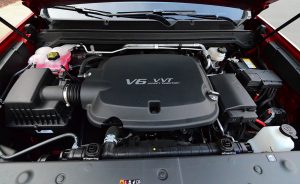
However, the Canyon’s V6 is paired only with an eight-speed automatic – while both the Tacoma and the Frontier offer manual transmissions with their V6s (as well as simpler five and six-speed automatics as options).
The Frontier and Tacoma are both older designs – which is by no means a bad thing – because their designs predate the increasingly over-the-top design of the newest things. Neither of those trucks have ASS, for instance – Automated Start/Stop. And their engines aren’t direct injected (the Canyon’s are), which means simpler port-fuel injection and no post-warranty worries about carbon-fouled valves – which is a worry with direct-injected engines.
You can pick either 2WD or part-time 4WD with driver-selectable High and Low range gearing. However, to get 4WD, you have to buy the V6. Or the Canyon’s third available engine.
Which is also a unique engine.
This is the 2.8 liter turbodiesel engine. It makes 181 hp and a very stout 369 ft.-lbs. of torque, as much as a typical 5.7 liter gas-burning V8.
Equipped with this Mighty Mouse of an engine, the Canyon can pull 7,700 lbs. – also best in class and by a significant margin.
The Tacoma’s max is 6,400 lbs; the Frontier’s 6,640 lbs.
The Canyon’s diesel comes paired with a heavy-duty six-speed automatic transmission (not the same transmission as the one used with the 2.5 liter engine) a heavy-duty cooling system and alternator – as well as an exhaust brake, just like the really big rigs.
No one sells compact-sized trucks anymore, in part because they lacked power and capability. The Canyon has both – no matter which of its three engines you pick.
The least it can pull (with its standard 2.5 liter engine) is 3,500 lbs. – which is as much (or more than) many compact trucks were able to pull, period.
With the diesel, it can pull almost 8,000 lbs. – which is very close to the capabilities of some full-size pick-ups.
With its mid-range 3.6 liter V6, the Canyon can get to 60 in just over 7 seconds. And while the manual-equipped version (with the standard 2.5 liter engine) isn’t as quick as that, it’s lots of fun being able to run through the gears yourself – and play with the clutch.
With the diesel – and the exhaust brake – you can play Big Rig (make the exhaust braaaaaaaaaap as you use compression to decelerate) without all the Big Rig downsides, including width.
The Canyon is a reasonably lithe 74.3 inches through the hips, about the same as most current mid-sized cars.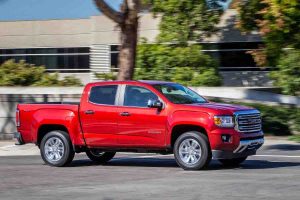
The just-redesigned 2019 Silverado 1500 is just over 80 inches through the hips, which means the Silverado often takes up every inch of space in its lane – or feels like it. The specter of smacking outside rearview mirrors with the car in the opposite lane is a constant worry – and dealing with drive-thrus is a close-run business, especially if you’re coming into one at an angle. Those concrete poles loom large as the gap between your expensive, shiny truck and a trip to the body shop gets narrower and narrower . . .
The Silverado’s great out on the range, in the wide-open spaces – where there’s limitless room to maneuver. As out on the open ocean. But closer to shore is another thing.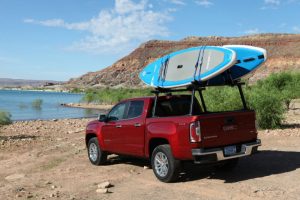
The Canyon’s a lot more everyday friendly in suburbia, which is pretty much the point and explains why GM doesn’t offer a regular cab/long bed variant. This is a truck made to be agreeable as a commuter, wife-drivable at the end of the school day – with guts enough to pull the boat to the ramp on weekends and cart the dog around in the bed whenever.
It’s not really a work truck – though it can be used to do real work.
And you don’t need a ladder to get into its bed, either.
The longest-available bed may only be a six-footer, but being able to load and unload it without a ladder (or a forklift) adds a degree of everyday ease-of-use that’s lacking in the the latest super-sized behemoths.
The Canyon’s visual proportions are a bit skewed; the bed is short relative to the cab and the bed’s walls are high relative to the length. But then all current mid-sized trucks share this same general look.
Interesting fact: The Canyon is actually about the same overall length (224.6 inches for the crew cab variant) as some ‘90s-era full-size (1500 series) trucks. But the lion’s share of the length is taken up by the cab rather than by the bed.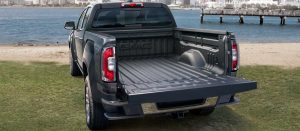
Still, the Canyon’s about two feet less long than a Silverado 1500 crew cab – which means it’ll fit in spots the Silverado has to pass. This may include your garage.
The main downside – and it might not be one if you don’t need it – is that the Canyon isn’t available in a “work truck” regular cab/long bed configuration, as most 1500s still are.
But none of its rivals offer that arrangement, either.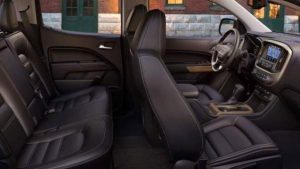
The standard extended cab has tight back seats – there’s only 28.6 inches of legroom, which is about three inches less than in a Mustang (which has 30.6 inches) though not as tight as the useless backseats in a Camaro (appx. 24 inches).
But they are roomier than the backseats in compact-sized trucks such as my ’02 Frontier (this is the old model; the new one is mid-sized, like the Canyon). And you can always upgrade the back seats by going with the crew cab, which bumps the legroom up to 35.8 inches.
While both bed lengths (6.2 and 5.2 foot) can be used to cart eight foot long items – with the tailgate down – you’ll need to cant things like 4×8 sheet of drywall or OSB sideways, which limits how many sheets you can carry per load.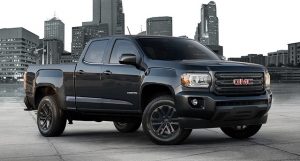
All trims come with an LCD touchscreen, but the SLE and higher grades get an upgraded 8-inch screen with 4G WiFi and three additional USB ports.
The optional All Terrain package is the same as the better-known Z71 off-road package available with the Chevy-badged Colorado (and other Chevy-badged trucks, including the Silverado). It includes off-road tuned HD shocks and suspension, a locking rear axle, skid plates and all-terrain tires on 17-inch wheels – plus heated seats and a heated steering wheel.
Which also accounts for the top-of-the-line Denali version of the Canyon, which is analogous to the Denali version of the GMC Yukon (as opposed to the Chevy Tahoe).
However, it’s very similar (other than superficialities) to the top-of-the-line equivalent Colorado, which will cost you a bit less because it’s a Chevy.
THE REST
All trims come with a capless fuel fill, which is nice because you never have to sweat losing the cap or having the “check engine” light come on because you didn’t tighten it all the way.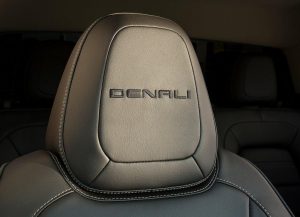
A damped EZ-Lift/Lower tailgate is available, too.
SLT and higher trims come with wireless sail fawn charging.
The Canyon’s optional diesel is expensive to buy – $4,965 – and Chevy only lets you tick that option if you also buy the higher-up (and so, higher-priced) SLE, SLT and Denali trims. But you could at least potentially earn that investment back by leveraging the inherently longer lifespan of a diesel engine, which ought to run reliable for at least 250,000 miles with regular maintenance.
It will also cost you less to drive – because equipped with this engine, a Canyon rates 30 MPG on the highway (the 2WD version) which is outstanding mileage for a truck with this level of capability.
It would be nice if GMC allowed you a choice of beds with the extended cab version of this truck. This one comes only with the six-foot bed; if you want the shorter bed you (oddly) have to buy the larger cab.
Some rivals – like the Toyota Tacoma – offer more latitude when it comes to picking cab/bed configurations.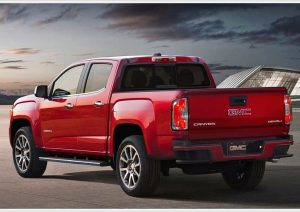
And others – like the Nissan Frontier – cost thousands less, at least to start. You can pick up a base trim Frontier for $18,990 (MSRP) and probably for closer to $17k once you wear down the salesman.
THE BOTTOM LINE
It’s not too big – and far from weak.
The truck’s main detraction isn’t the truck itself. It’s the way GM “bundles” and “packages” desirable options with ones you may not desire to pay extra for.
Or denies you the combinations you’d prefer, if you could pick and choose.
. . .
Got a question about cars – or anything else? Click on the “ask Eric” link and send ’em in!
If you like what you’ve found here please consider supporting EPautos.
We depend on you to keep the wheels turning!
Our donate button is here.
If you prefer not to use PayPal, our mailing address is:
EPautos
721 Hummingbird Lane SE
Copper Hill, VA 24079
PS: Get an EPautos magnet (pictured below) in return for a $20 or more one-time donation or a $5 or more monthly recurring donation. (Please be sure to tell us you want a sticker – and also, provide an address, so we know where to mail the thing!)
My latest eBook is also available for your favorite price – free! Click here. 


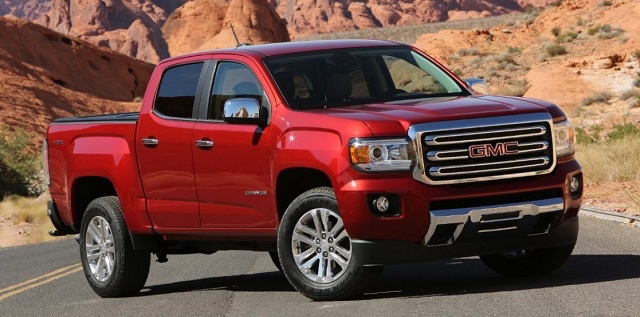



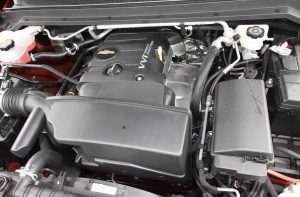
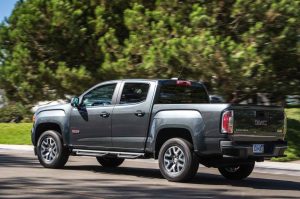
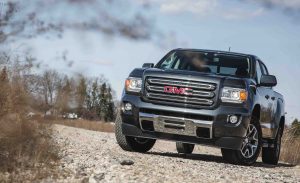










The Jeep Gladiator will be adding a diesel next year in the segment as well. It’s the same Ecodiesel from the Ram/GC. But interestingly the Gladiator’s max tow option is the base v6. Apparently shoehorning the v6 oil burner into the engine bay limits cooling.
Jeep has also been touting the low bed walls and that you can touch the bed floor standing on the side. But I suspect that this is an after the fact talking point, when it’s really a styling thing (the bed matches the body line of the door glass).
Uniquely, the Jeep can also carry 4×8 sheet goods in the bed, but not between the wheel wells. There is a notch forward to hold a 2×4, which along with the tailgate’s half open position, will hold plywood flat and above the wheel wells.
Of course the Gladiator will also be significantly more expensive in it’s base trim than the other mid size trucks, which may end up pushing me towards the GM twins.
The super Wrangler pickup may have some good uses for some people, but it’s a shame to use the Gladiator name. The original Gladiator was a real pickup and the 3/4 ton version could carry a cabover camper.
I guess what the world really needs is more crew cab “pickups” with really short beds ……
I too wish that they’d reserved the nameplate. Scrambler would have made more sense, as a Wrangler derived pickup, and using Gladiator essentially kills the minuscule chance of a Jeep half ton.
But Jeep has been loudly insisting that it’s a legit truck, and not just a Wrangler with a bed, so I get why they went with a truck nameplate.
But then they cheap out by copying the JL from the bed forward (save larger grill slots). They have to know that anybody looking at it is going to see Wrangler… not Gladiator.
It’s especially frustrating because they could have at least honored the original, by using the M715 front end that they’ve used on multiple truck concepts.
Or “Comanche” ???
Maybe they figure that if they made a Real Pickup instead of just another ridgeline avalanche, that it would cut into the sales of FCA Bighorn pickups?
Comanche would have been a decent choice as well, as all the mid size trucks were once compact. But then the Wrangler styling issue remains.
Jeep also did a Comanche concept, based on the Renegade, a couple years ago. If the Gladiator succeeds they might go that route.
I’m absolutely sure that they don’t want to cannibalize Ram sales.
FCA has positioned the Gladiator as a “lifestyle” vehicle that will be “expensive, intentionally so,” and that they don’t view the Taco/GM twins/Ranger as it’s competition.
With rebates you could very likely get ot the door in a 1500 for the same, or under the Jeep. Pricing is supposed to be finally released at 12am this Saturday (30th).
Rumor is that the platform will underpin a future Dakota for the regular mid size market, although probably modified with IFS instead of a solid axle up front. Might also see other cab/bed options here.
Hi all, these things are the ‘dual cab utes’ of Australia – we don’t really get your full size pick ups in any sort of volume (pity). Here’s a comparison article, the GMC is similar to the Holden Colorado.
https://www.caradvice.com.au/632746/2018-ute-mega-test-review-ford-ranger-v-toyota-hilux-v-mitsubishi-triton-v-nissan-navara-v-holden-colorado-v-isuzu-d-max-v-mazda-bt-50-v-volkswagen-amarok/
Note also the prices we pay for them: you guys getting a start at $22K USD is incredible! We are being ripped off blind on the things (and queuing up for the opportunity to be ripped off). $47,180 AUD for Colorado base model at exchange of 0.7178 USc is a list price of nearly $34,000 US!
The Ranger that is on the way to you is Aussie designed, Thai built for our market, and regularly wins both the comparisons here, and the sales race. Other than that, all of them are diesel pretty much, and there have been problems with some of their DPF filters (expensive consumable part) and injectors. It would be better with more petrol variants here – cheaper overall running costs
Cheers
Hi Jack,
Thanks for the link and advisory!
You Aussies pay more – which sucks – but you also get vehicles we’re denied, like the HiLux for one. You guys also got some cool RWD Holdens we never had access to.
It’s s shame we can’t spray Raid on our respective “Uncles”!
And the prices of our vehicles have gone much higher since the demise of local manufacturing. And try getting parts for the 52 makers of vehicles sold here. 3-5 times higher than a legitimate price and have to wait months because the parts are not in stock. Even for Toyotas.
Console delete available ?
Hatred of these space wasting things grows year by year
Yeah, who wants a washing machine sitting between you and your sweetheart ???
Amen, MHRA!
PS: Great handle…!
I am not a pickup guy, but I would like to have a truck with the width of this one and a 7 foot bed and it would be about 1-2 inches lower. Towing capacity would be at least 7,000 lbs. I would take a regular cab or an extended one with back seats, but no rear doors.
Hey Swamp,
The defunct Dakota was very close to what you want: 6 1/2 foot bed, significantly lower and a towing capacity up to 6500 pounds. I have one and, like Eric, hope to keep it forever.
Cheers,
Jeremy
What year did they manufacture these trucks? Was it with a 6 or a V8?
Hey Swamp,
In a form similar to mine, from 1997 to 2011. It was available with a 6 or an 8. Mine is a 2002 with the 4.7L V8, extended (not club) cab and a 5 speed manual. I know they discontinued the manual V8 option, but not sure when.
I have 184,000 miles on the truck and the only major service was a new clutch at around 160,000. Granted I take good care of it, but mine has been extremely reliable.
Cheers,
Jeremy
Swamp,
I’ve also got a 2005 v8 auto. I like mine. Most reliable vehicle I’ve owned – I’m at 140,000 miles biggest repair has been a 02 sensor and it’s low, I can reach over the bed rails to grab things. My biggest gripe is small fuel tank 300 mile range or so… almost as bad as an EV.
I like this Canyon, except for the tall ride height. I always said the Dakota would be perfect with a little Diesel, but nowadays Diesel is nearly $1 more than RUG and the new emissions equip have put a damper on things for me.
Hey Eric,
You are a totally prolific writer. Kudos. The GMC Canyon 4X4 is tempting with the V-6 or diesel options. Especially if you have money to burn. It’s actually a fairly large truck with good specs. My beef with GM (aside from the “other issues”) is cheap parts. I had a new loaded 2008 Silverado LTZ that was nice, but some of the cheap plastic parts broke and the 5.3 couldn’t tow worth a damn. And, I’ve rented several new Silverados, and granted, they were base models, but with 2,000 to 5,000 miles on them should they be making all sorts of weird noises and the brakes and transmissions be herkey jerkey? And the motors surging? Don’t think so. Maybe GM puts better components on their higher end models now? Had one Silverado 4X4 rental I couldn’t even get off the lot, the drive train was locking up. Probably from idiot renters driving it in 4WD on the hard pavement and ruining the drive train. Good job Enterprise! Maybe they learned not to rent 4X4s to idiots. Hehehe!
Aloha, Vic
Thanks, Vic!
What I’d really like to see is a compact truck with a diesel engine; something that could pull 5,000 lbs. or so and get 30 MPG, do real work, last 300,000 miles and cost about $22k new.
I can dream, I know…
With the rise of online shopping you’d think someone would let you go though the laundry list of options and pick one-by-one. It would probably be easier from a site developer’s perspective, somewhat customer friendly, and less error prone because you could just send the order directly to the factory.
But instead when you click on an option you get a pop-up “to get this option you have to take the X upgrade.” So now you get a bunch of stuff you have no interest in, just because it makes it easier for the dealer who’s picking up inventory for their lot.
Anyone remember when the dealers would come up with their own packages? I’m too young for it, but I’ve seen the videos.
Hi RK,
I often wish I still had my ’98 Frontier. That year, you could buy 4WD without also buying the V6. And with a regular cab. It was the perfect little truck for me. Today, there is nothing remotely similar. Either in terms of size – or price. To get into a 4WD anything, you’re looking at $25k-plus and over $30k for a 1500…
Isn’t it annoying as heck? The worst part is when you do that it also lists 50 things that are being removed from your current build you just spent 10 minutes adding to your ride.
It used to be that you could order a pickup with virtually any combination of options or lack thereof, whether it made any sense or not. Potential resale value was left up to the buyer’s discretion.
Including five or six different engines such as: 250-I6, 292-I6, 305-V8, 350-V8, 400-V8, 454-V8 (only you couldn’t get big blocks in a GM 4×4 until sometime up in the 1980s I think).
Not to mention of course a REAL 6′ x 8′ pickup bed. While I think the crew-cab/short-box is a great option for some people and wonder why it took them so long (Dodge actually had one way back, I think), how did we get to where that is the ONLY option ???
These remind me of the size the 90’s 1500’s used to be. Your right, the new 1500’s are very large.
Does anyone offer a small truck like the old Toyota anymore or S10?
Arrrrggghhhh! JUST HAVE 48″ BETWEEN THE WHEEL WELLS ALREADY!!!!! The damn thing is as big as the old Silverado’s but still can’t carry a stinkin’ sheet of plywood!!! I would almost investigate cutting the stock wheel wells OUT, then having some custom made that give the necessary clearance. Just run a little skinnier tire in the back. All those truck beds are basically “open top trunks”. Sheesh.
The Honda Ridgeline will carry a sheet of plywood flat between the wheel-wells. But like all the midsized pickups, you’ll have to leave the tailgate down because none of them have the bed length..
Bonus: It actually does come with a trunk. Which is weather-tight and locks, so you can keep your tools in it (no need for a truck box). It also has the best ride of any mid-sized pickup.
My neighbor confirms the ride in his ridge line is superior to his silverado work truck.
they are still too tall with their ass in the air. Frontiers and Tacos don’t have that appearance.
“having the “check engine” light come on because you didn’t tighten it all the way.”
Or tightened it beyond a single click. Toyota V6s will do that.